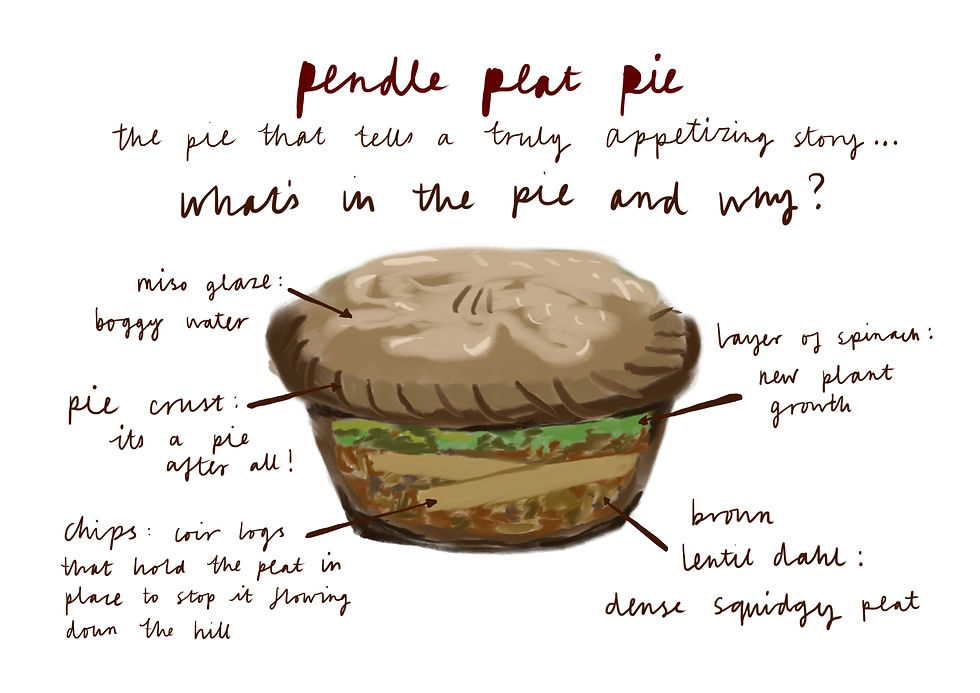What does it mean to eat a Pendle Peat Pie?
- Frankie Turk

- Aug 24, 2022
- 3 min read
Updated: Sep 17, 2024
Peat soil is an expressive material. It's formation so slow and delicate that you can still see the decay of a leaf from many centuries ago. Peatlands are special places, taking up just a fraction of the earth's surface yet storing more carbon than any other terrestrial ecosystem. They are water sources, providing life to those around them. Yet, in many parts of our planet these precious lands are being eaten into. Today there are vast areas of open brown peat soil exposed to the air, eroding and dispersing. We eat into our peatlands when we drain, burn and extract them.
"When I first learnt about peatlands and their powerful role in the climate and ecological system I had the feeling that the earth beneath my feet was suddenly not what it seemed to be."
For me, this is the starting point of the Pendle Peat Pie project. To, on the one hand, celebrate the regeneration of the Pendle Hill peatlands, and on the other, highlight our intimate connection with these ecosystems.The project tells the story of the local people’s work, replanting and rewetting the peat on Pendle Hill and highlights the peatland’s role in creating flood protection, fire prevention, biodiversity and clean water for the area. In fact, this tale of local transformation goes beyond the Pendle Hill community because the cooling effect from the carbon storage will have global implications, reaching others in most impacted places. This edible collaboration between an artist, an ecologist, and a cook, reminds us that the restoration of our landscape both nourishes us directly, and brings us closer to our community.

"...both recipe and peat can be looked at as records of our human histories and ever changing identities."
The food we eat both unites us with the soil, and with our cultures and traditions. In the case of the Pendle Peat Pie, there is a coming together of traditional flavour and form, a culinary re-rooting if you like. The pie is often seen as the quintessential dish of northern England, while its South Asian inspired lentil filling dispersed with chips, honours the mixed heritage present in the area today. Cultures are formed slowly just like a peatland. While eating this pie, I am reminded of the passing down of recipe from parent to child, from one generation to the next forming food cultures and traditions. It makes me think of how the layers of peat are thickened over the duration of entire civilisations, forming through countless culinary turning points. In this way, both recipe and peat can be looked at as records of our human histories and ever changing identities.
"Rewetting and restoring our peatland ecosystems may be one of the most urgent tasks of this decade"
When I first learnt about peatlands and their powerful role in the climate and ecological system I had the feeling that the earth beneath my feet was suddenly not what it seemed to be. In that moment, the world I knew was once again surprising. It was the kind of unearthing surprise I got when I first grasped that the beach I was laying on was made of the shells of a million dead sea creatures, or that the trees around me could communicate through the fungal networks beneath the forest ground. Without warning I was exposed to a complex and deeply embedded system that was taking place around me. One with a more ancient force than my short life-span could fully comprehend.

Image: Frankie presenting a youth-themed session at the COP26 Peatland Pavilion in Glasgow
These ecosystems may look muted but they are far from it. Rewetting and restoring our peatland ecosystems may be one of the most urgent tasks of this decade, for without healthy peatlands we will not stay below the 1.5 degrees warming, without their habitat we will lose ever more creatures and unique plants and we will leave ourselves ever more vulnerable to the rapidly changing weather patterns.
"eating a Pendle Peat Pie becomes connected with communicating, sharing and growing...To be nourished by the peat and to nourish it in return."
The story of the peatlands is one that will take many voices. Meal times are an opportunity to bring people together, they are some of the most important storytelling moments in our busy lives. In that way, eating a Pendle Peat Pie becomes connected with communicating, sharing and growing. This project is an opportunity to open your mouth, to eat some delicious pie and to talk about this topic. To be nourished by the peat and to nourish it in return.
Frankie Turk is is a founding member of the youth-led collective RE-PEAT, an organisation that approaches the topic of peatlands through interdisciplinary collaborations, education programs and creative means of communicating.
Frankie created the Pendle Peat Pie illustrations as part of the collaboration with Kerry Morrison on Deep Peat as part of The Gatherings, with Pendle Hill Landscape Partnership.






